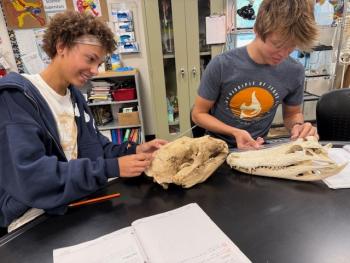
FIND IT FUND IT FLORIDA
It’s a Zoo in Here! Amazing Animal Anatomy Specimens

- School:
- Magnet Innovation Center
- Subject:
- STEM Education
- Teacher:
- Margaret Aresco
- Deidre Meadows
- Students Impacted:
- 75
- Grade:
- 9-12
- Date:
- October 1, 2025
Investor
Thank you to the following investor for funding this grant.
The St. Joe Community Foundation - $1,500.00
Goal
In order to truly appreciate and understand the diversity of life, students must have the opportunity to observe and study real organisms. This project will supply high school biology students with quality, durable zoology and anatomy specimens that can be used for many years. This project will allow students to observe and study animal specimens that might be difficult or impossible to observe in nature, such as snakes, bats, and insects.
Category
Learning Aids - Sunshine state book sets, robotics kits, puzzle boards, science models, engineering supplies, etc.
What will be done with my students
This grant will be used to purchase a variety of animal specimens preserved in acrylic blocks, including dissections with anatomical structures labelled, skeletons, and organ surveys. In addition, a microtome will be purchased to allow students to make their own microscope slides using animal tissue samples, such as liver. Students will observe and sketch the animal specimens during lab activities, and using the dissection specimens, they can conduct comparative anatomy surveys. Studying animals present a unique challenge, because unlike plants and fungi, they are highly mobile and can be difficult to collect and observe.
Having durable, long-lasting specimens of real animals will allow for many years of up-close observation and hands-on learning. High school students have the opportunity to take Biology as freshmen and then dual-enrollment college Principles of Biology 1 and Principles of Biology 2 as upperclassmen. In addition, students in Anatomy & Physiology and Environmental Science will use these specimens during lab activities. These animal specimens will be used during all biology classes as students study animal diversity and anatomy in 3 at least classrooms and benefit approximately 75 students every year.
These zoological and anatomical models will be used to increase student engagement while learning the following standards:
SC.912.L.15.4 Describe how and why organisms are hierarchically classified and based on evolutionary relationships.
SC.912.L.15.7 Discuss distinguishing characteristics of vertebrate and representative invertebrate phyla, and chordate classes using typical examples.
SC.912.L.15.6 Discuss distinguishing characteristics of the domains and kingdoms of living organisms
SC.912.L.14.13 Distinguish between bones of the axial skeleton and the appendicular skeleton.
SC.912.L.14.26 Identify the major parts of the brain on diagrams or models.
SC.912.L.17.6 Compare and contrast the relationships among organisms, including predation, parasitism, competition, commensalism, and mutualism.
Benefits to my students
Students in high school biology classes greatly benefit from hands-on lab activities that help them connect the information they learn during lecture and reading activities to real living organisms. These acrylic block animal specimens can be viewed and studied from all angles, and even placed under our dissecting microscopes for closer examination. These durable specimens also reduce the number of animal specimens necessary for lab, because they can be reused for many years.
Budget Narrative
A variety of durable acrylic block animal specimens will be purchased for use by students in lab. Dissections of six species (rabbit, pigeon, lizard, toad squid, clam) have all major internal anatomical structures labelled and come with a numbered guide. Skeleton blocks of 3 vertebrate species (frog, bat, snake) will allow for comparisons of the unique adaptations for locomotion of these three species (jumping, flying, legless crawling). Insect and tarantula blocks will allow students to learn the classification and characteristics of arthropods including insects, the most diverse group of animals on Earth. Comparative anatomy blocks (hearts, brains) demonstrate the adaptations of anatomical structures in different vertebrate groups. The frog development block will allow students to observe the unique development pathway of amphibians. Finally, a handheld microtome will allow students studying anatomy to learn the valuable skill of making microscope slides of fresh tissue, such as muscle or liver, and examining the slides under the microscope.
Items
| # | Item | Cost |
|---|---|---|
| 1 | Ed Speldy Dissection Specimen Block - Rabbit | $180.00 |
| 2 | Ed Speldy Dissection Specimen Block - Pigeon | $138.00 |
| 3 | Ed Speldy Dissection Specimen Block - Lizard | $89.00 |
| 4 | Ed Speldy Dissection Specimen Block - Toad | $74.00 |
| 5 | Ed Speldy Dissection Specimen Block - Squid | $60.00 |
| 6 | Ed Speldy Dissection Specimen Block - Clam | $58.00 |
| 7 | Real Bat Skeleton Specimen in Resin | $29.00 |
| 8 | Real Snake Skeleton in Acrylic Block | $38.00 |
| 9 | 20 Pcs Insect in Resin Specimen Collection | $34.00 |
| 10 | Real Frog Full Skeleton Specimen in Acrylic | $44.00 |
| 11 | Frog Development Plastomount | $70.00 |
| 12 | Comparative Brains Plastomount | $156.00 |
| 13 | Tarantula Plastomount | $64.00 |
| 14 | Comparative Hearts Plastomount | $156.00 |
| 15 | Sponge collection Biorama | $165.00 |
| 16 | Hand Microtome (to make microscope slides) | $101.00 |
| 17 | large plastic storage tub for specimens | $44.00 |
| Total: | $1,500.00 |





Share
Please share this page to help in fulfilling this grant.
Email to a Friend